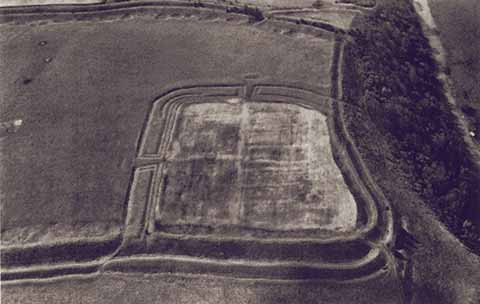The briefest of battles
Archaeology at Hod Hill provided a unique insight into life before and after the Roman invasion, says Roger Guttridge
Published in November ’19
 IT’S THE SUMMER of AD 43 and a wave of fear is spreading through Dorset. Across the rural landscape, horsemen gallop from farm to farm, bringing news that no-one wants to hear: the Romans have invaded south-east England. Dorset could be next. The native Durotrige tribe begin preparations for battle, including reinforcement of their hillforts. In some places, such as Hod Hill near Stourpaine, this defensive work is still in progress when the invaders arrive.
IT’S THE SUMMER of AD 43 and a wave of fear is spreading through Dorset. Across the rural landscape, horsemen gallop from farm to farm, bringing news that no-one wants to hear: the Romans have invaded south-east England. Dorset could be next. The native Durotrige tribe begin preparations for battle, including reinforcement of their hillforts. In some places, such as Hod Hill near Stourpaine, this defensive work is still in progress when the invaders arrive.
‘At Hod Hill the outermost works were still in process of amplification with a view to improving weak points in the circuit,’ wrote Professor (later Sir) Ian A. Richmond following the British Museum’s seven-year excavation in the 1950s. But he adds: ‘All was in vain. The powerful defences, consisting of two ditches rendered more formidable by the banks of the upcast disposed on their outer edges and a huge rampart, were not taken by assault; but an important hut-dwelling inside the area was subjected to a bombardment with iron bolts from the ballista or spring-gun.’ This is presumed to have been the Durotrigian chieftain’s hut.
Unlike at Maiden Castle, where archaeologists found clear evidence of prolonged and heavy fighting, Hod Hill’s defenders appear to have gone with a whimper. ‘It would appear that they were quickly cowed into surrender,’ said Professor Richmond. ‘Thereafter the hillfort was emptied of inhabitants; its gateways were dismantled, and the great rampart despoiled of its upper works or walled crest.’
The professor’s early summary of the Hod Hill dig appeared in October 1958 in the Sturminster Rural District News Letter, twelve editions of which have been returned to Dorset by Rev. Barrie Hirst, who was Sturminster Newton’s Methodist Minister in the 1960s. The report brings to life aspects of life at Hod Hill before and after the Roman invasion.
‘By Roman standards, the dwellings inside had not been of comfort,’ said Professor Richmond of the Durotrigian facilities. ‘The round huts, with roofs of thatch or turf and walls of clay and chalk cob, cannot have afforded much more than a smoky shelter, crowded, noisy and evil-smelling. Much of the work on the hill, such as corn-grinding, carpentry or spinning and leather-preparation, was done out of doors in working enclosures screened off by palisades or hurdling. The eating-corn was stored in pits, the seed-corn in small granaries on stilts, safe from damp and vermin. The chariots and horses were kept in stable-enclosures, attached to the huts of their grooms. All this the Romans brought to an end….’
Having evacuated the locals, the invaders then did something unique. In one corner of the sixty-acre hillfort they created their own seven-acre fort, suggesting that they expected the Durotriges to strike back at some point. ‘The defences of the Roman fort still form one of the most remarkable examples of such works in Britain, and almost the sole example of its kind south of the Humber,’ said Professor Richmond. ‘Nowhere else in these islands is the remarkable combination of a Roman fort placed inside a native hillfort to be seen. This was in fact rarely done; and, when the act occurs elsewhere in the Roman world, it is always associated with the moment of conquest, before the time for the selection of permanent positions had come. The buildings and garrison of the Roman fort both reflect such provisional arrangements at Hod Hill. The defences, on the other hand, are more permanent in character, for they at least in newly conquered territory could not be skimped.’
The Romans’ own Hod Hill fort included a rampart ten feet thick and originally of similar height. It was built of chalk upcast from the ditch-digging and retained by turf-built ‘cheeks’ at back and front that were also laced with timbers. Two rock-cut ditches that Richmond describes as ‘deep and dangerous’ lay in front of it and next to that a wide flat space bordered by a third ditch.
The Roman fort had three wooden gates. The east gate featured a double passageway flanked by towers; the south and south-east gates were single entrances, each crowned by a tower. All the buildings within the fort were of timber construction but the archaeologists were able to work out their plan by recovering their foundation trenches. Professor Richmond said that the remains of the Roman fort provided a ‘unique picture of the accommodation for a combined force of cavalrymen and legionnaires, whose identity is proved beyond doubt from the numerous items of equipment belonging to each type of unit, which were recovered when the site was ploughed in the 19th century and which are now in the British Museum.’ The legionary detachment would have consisted of 600 men, while the cavalry regiment comprised 250. The Romans are thought to have occupied the site from AD 44-51, during which time they were advancing their conquest of south-west England. The artefacts ploughed up in the 19th century were collected by Henry Durden (1807-92), a Blandford grocer and antiquary, whose son sold them to the British Museum soon after Henry’s death.

